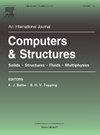Symbolic deep learning-based method for modeling complex rate-independent hysteresis
IF 4.4
2区 工程技术
Q1 COMPUTER SCIENCE, INTERDISCIPLINARY APPLICATIONS
引用次数: 0
Abstract
Many hysteresis models have been proposed and applied in engineering practices to describe and predict complex hysteretic behaviors observed in various engineering systems. However, selection of suitable hysteresis model usually costs extra time. In this paper, a symbolic deep learning (SDL) based method is proposed to fully describe the complex hysteresis behavior of structural systems and generate hysteretic model that fit experimental or simulated data. An explicit expression for nonlinear analysis can be obtained through symbolic deep learning without extra steps of model selection or parameter identification. The proposed method can be utilized in the modeling of complex hysteresis behavior including asymmetry, pinching, and degradation. Data from three classical hysteresis models including Bouc-Wen, generalized Bouc-Wen and Bouc-Wen-Baber-Noori, as well as the experimental data from pseudo-static testing are utilized to validate the performance of the proposed SDL model. The error accumulation and the influence of input noise is discussed.
基于符号深度学习的复杂速率无关迟滞建模方法
许多迟滞模型已被提出并应用于工程实践中,以描述和预测在各种工程系统中观察到的复杂迟滞行为。然而,选择合适的迟滞模型通常需要花费额外的时间。本文提出了一种基于符号深度学习(SDL)的方法来全面描述结构系统的复杂滞回行为,并生成适合实验或模拟数据的滞回模型。通过符号深度学习可以获得非线性分析的显式表达式,而无需额外的模型选择或参数识别步骤。该方法可用于不对称、挤压和退化等复杂迟滞行为的建模。利用Bouc-Wen、广义Bouc-Wen和Bouc-Wen- baber - noori三种经典迟滞模型的数据以及拟静态测试的实验数据验证了SDL模型的性能。讨论了误差累积和输入噪声的影响。
本文章由计算机程序翻译,如有差异,请以英文原文为准。
求助全文
约1分钟内获得全文
求助全文
来源期刊

Computers & Structures
工程技术-工程:土木
CiteScore
8.80
自引率
6.40%
发文量
122
审稿时长
33 days
期刊介绍:
Computers & Structures publishes advances in the development and use of computational methods for the solution of problems in engineering and the sciences. The range of appropriate contributions is wide, and includes papers on establishing appropriate mathematical models and their numerical solution in all areas of mechanics. The journal also includes articles that present a substantial review of a field in the topics of the journal.
 求助内容:
求助内容: 应助结果提醒方式:
应助结果提醒方式:


